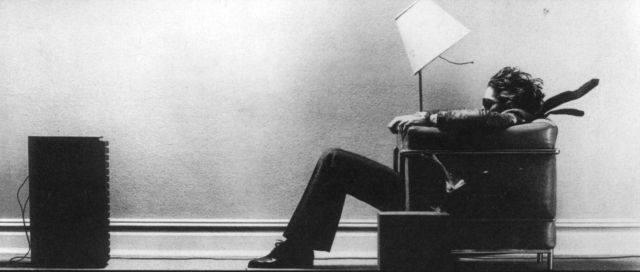introduction to electroacoustic music
assignments
aIV
|
introduction to electroacoustic music |
assignments aIV |
FPA 147 Assignment IV: L i s t e n i n g _ J o u r n a l
Due: April 2nd. Submit electronically as a Word .doc, .docx or .rtf, or PDF only. Email as directed. File must be labeled yourname_assign_4
What?: The Listening Journal focuses upon writing descriptions and comments of your aural experiences as you listen to electroacoustic music pieces. You will need to listen to 8 pieces.
Procedure: Write two paragraphs (minimum) about what you heard for each piece.
What to write about:
First - please avoid comparisons to subjective experiences (“it sounds like a chase scene in a movie", or "it makes me feel like I'm lying in a boat, watching the stars...”). Your descriptions should be based upon what you hear(i.e. objective), not how it makes you feel (i.e. subjective)! Use the terminology that you are learning in this class, and discuss the sound objectively. A fixed or formal style of writing is not expected. This is not a typical academic writing assignment, it is more like a diary describing your thoughts and listening experiences. The idea for the sound journal is to encourage you to listen to music that you probably have never heard before in a critical manner. Marking will be based upon your observations, rather than any factual material or extra research put into each answer (in other words, do not rewrite any relevant CD liner/web material, notes, etc. you may come across!). Lastly, these are not "blind" listenings - you know who the composer is, the work, and, hopefully, its relationship to the history of EA. Please keep these aspects in mind while writing.
Actual Student Example:
This piece uses concrete sounds, so I'm tempted to say this is a music concréte work. However, this work dates from the early 1990s, so it must be acousmatic. Harrison is the composer who suggested the EA music could meet at Schafer St. and Rue Schaeffer, which suggests that, unlike true acousmatic work, the context of the sound (in this case wine glasses) does matter. Throughout the piece the sounds created by wine glasses are used and filtered in order to create new textures and spectrums. Unity is created through the similarities in the source, but he uses many advanced techniques to change the sounds in order for variation. I think I hear some equalization as well to get some of the higher frequencies and it seems in parts that the wine glasses resonate (which I guess they do naturally as well) but this seems more enhanced in this piece. There is also an excellent use of transition between the sounds that help the micro envelopes evolve and for the sound to take new forms. It seems to sway between recognizable, obviously filtered, and very different sounds. The gestures within the sounds also seem to sway and vibrate back and forth as well. A short but very interesting piece.
Pieces to Choose From:
You may choose any electroacoustic work by the following composers:
Barry Truax
Pierre Schaeffer
Karlheinz Stockhausen
John Cage
Edgar Varese
Hildegard Westerkamp
Pauline Oliveros
Robert Normandeau
Paul Lansky
Martin Bartlett
Francis Dhomont
John Chowning
Michael McNabb
Mark Wingate
Charles Dodge
Iannis Xenakis
Francois Bayle
Yves Daoust
Giles Gobeil
plusany piece found on the OHM collection, the emprientes DIGITALes label, the Culture Electronique series, Computer Music series, the Bourges Festival series, etc. If unsure, please email the instructor.
Evaluation: Quality of observations, ability to apply terminology learned in class to listening (historical perspective, compositional elements, technical description). (Worth 25% of your grade)